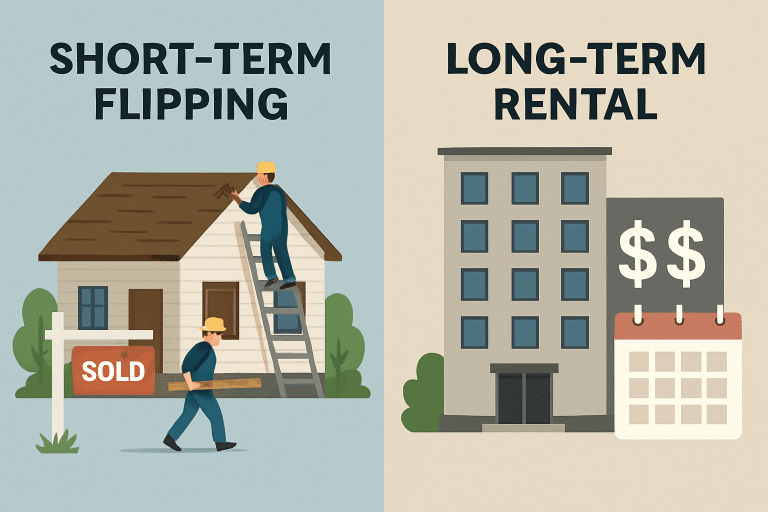Long-Term Strategy vs. Short-Term Gains in Real Estate Investment
Key Takeaways
- Short-term real estate investments can offer rapid profits but are susceptible to significant risks and higher tax burdens.
- Long-term strategies provide consistent rental income, resilience against market volatility, and attractive tax advantages.
- Shifting market trends and evolving regulations are increasingly favoring long-term investment approaches.
- Investors should align their strategies with their financial objectives, risk tolerance, and available resources.
Introduction
Navigating the world of real estate investment requires a clear understanding of the various strategies available to investors. The decision between seeking short-term rewards or developing a long-term portfolio can significantly influence both risk exposure and ultimate financial outcomes. Industry leaders such as John Picerne exemplify how the chosen investment philosophy can shape results across different market cycles.
As economic forces shift and regulatory environments evolve, investors must weigh their preference for immediate returns against the promise of long-term, compounding growth. Each approach offers unique opportunities, challenges, and implications that can align with—or conflict with—personal financial goals and tolerance for risk.
Defining Short-Term and Long-Term Real Estate Investments
Short-term real estate investments usually involve purchasing undervalued properties, performing renovations, and reselling them quickly for a profit—a strategy often referred to as “flipping.” This model depends on speed, market timing, and the investor’s ability to add value efficiently.
The entire investment cycle can sometimes last mere months, making it attractive for those seeking quick financial wins. However, rapid turnaround amplifies exposure to market shifts and unforeseen costs.
In contrast, long-term real estate investments focus on acquiring and holding properties for several years or decades. Investors generate income through rent collection and can benefit from property appreciation, leveraging the power of passive income and compound growth over time. Long-term strategies often appeal to those seeking financial stability, steady returns, and tax advantages associated with holding assets.

Financial Returns: Immediate Profits vs. Sustained Growth
The financial rewards of short-term investments are undeniably tantalizing. Successful property flips in favorable markets can yield returns surpassing 20-30% per transaction, provided renovations are controlled and market demand remains strong. Multiple successful flips in sequence can compound returns, but profits are highly sensitive to project timelines, material costs, and sales velocity.
On the other hand, offers a more predictable and multifaceted return profile. Rental properties can generate average annual returns in the 8-12% range, taking into account cash flow, appreciation, and equity buildup through loan paydowns.
This model benefits from the passage of time, harnessing market appreciation and, frequently, rental income that grows with inflation. According to Investopedia, long-term real estate investments have historically provided resilience during economic downturns and consistent wealth creation across multiple market cycles.
Risk Profiles: Market Sensitivity and Investment Stability
Flipping properties, as a short-term tactic, exposes investors to heightened risk. Profits can erode rapidly if the local market suddenly cools or renovation costs run over budget.
Furthermore, short-term gains are taxed at regular income rates—sometimes as high as 37% for top earners—resulting in reduced net profitability. Regulatory changes, interest rate hikes, or shifting market sentiment can quickly impact exit strategies.
Long-term investments are better insulated from sudden market downturns. By holding onto properties through market cycles, investors can weather temporary declines and benefit from eventual appreciation and stable rental income. Tax advantages also work in their favor, as these investments qualify for long-term capital gains rates, typically capped at 20%. Depreciation deductions and the opportunity to perform 1031 exchanges can further improve after-tax returns.
Operational Considerations: Management Intensity and Time Commitment
Short-term investing is a hands-on endeavor that demands expertise in property valuations, renovations, project management, and quick sales. The process often requires frequent site visits, contractor negotiations, and rapid decision-making—all while closely monitoring market trends. Burnout can occur if the investor lacks a robust support system or sufficient experience.
Managing properties for the long haul presents different operational challenges. While tenant management, maintenance, and regulatory compliance are constant factors, many of these can be streamlined through professional property management services.
This enables investors to scale their portfolios and delegate day-to-day responsibilities, striking a balance between steady income and manageable oversight.
Tax Implications: Understanding the Financial Impact
Tax strategy is a central concern in designing a real estate investment plan. Unlike short-term flipping, where gains are taxed at ordinary income rates, long-term holding unlocks lower capital gains taxes as well as deductions for depreciation and mortgage interest.
Investors leveraging strategies like the 1031 exchange can defer capital gains taxes by reinvesting proceeds in similar properties, a significant advantage for portfolio growth. Understanding these nuances is critical, as mismanagement or poor planning can erode intended profits.
Market Trends and Future Outlook
Recent shifts in the real estate landscape have showcased a growing interest in long-term rental strategies. Rising insurance premiums for short-term rentals, tighter local regulations, and economic uncertainty have led many investors to seek stability in buy-and-hold models.
Industry analysts predict that an estimated 1.5 to 2.3 million former short-term rental properties could return to long-term usage within the next three years, dramatically altering both supply and investor focus. This shift suggests long-term investment strategies are increasingly favored for their resilience and reliability in changing times.
Final Thoughts
The debate between short-term gains and long-term strategies in real estate investment boils down to one’s financial goals, risk tolerance, and commitment of both time and resources. While flipping properties can provide fast returns, these come with greater risk and tax burdens.
Long-term investments, by contrast, offer sustainable income, potential for appreciation, and a suite of tax advantages that can build generational wealth. As market conditions continue to evolve, investors who thoughtfully align their strategies with overarching goals are best positioned to








